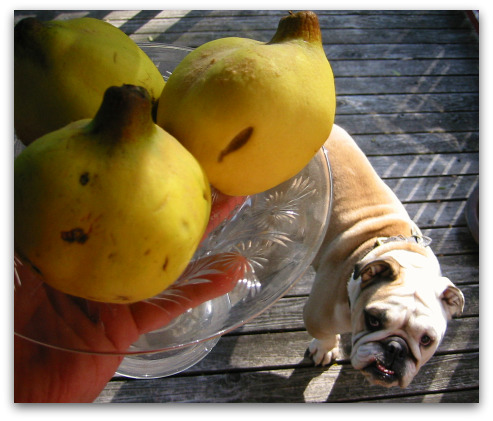
White-flesh Charlotte peach, this year’s star performer
Greetings fellow peach aficionados. Unfortunately, 2009 was not a bumper year for peaches here at tall clover farm (a pronouncement duly noted by the case of Yakima peaches resting at my feet). Our unusually hot, dry summer would have ushered in a nice crop if only spring felt obliged to share the same temperament. It doesn’t matter how hot your summer is if your spring is cold and wet. Peach blossoms played to an empty house, attended only by raindrops and windstorms. Bees were having nothing to do with it.

Four years since planting, the Charlotte tree produced its first peaches.

Other than covert night operations by raccoons, no pest problems to speak of.

Peach trees from left to right: Indian Free, Q-1-8, and Charlotte (in the shade)
In 2008, I posted the peach season’s results for my young peach orchard, and will offer up the results for 2009 below.
The following trees are peach leaf curl resistant varieties planted 3-5 years ago on Vashon Island, Zone 8, a moderate climate that ranges from 35-45 degrees daily in January to 55-75 degrees in August.
• Autumn Rose Peach
2009: Died. May it rest in peace. The tree was planted bareroot one year ago and it succumbed to peach leaf curl this spring and never recovered. I will not replant it.
2008: Planted bareroot this spring, leafed out with a bit of leaf curl, new growth moderate
• Avalon Pride Peach
2009: I love this peach and am not giving up on it. Good growth from one tree, minimal from the other. No leaf curl to report and no fruit set either. Again, this was a great backyard peach when I lived in Seattle.
2008: Steady growth, leaves good, minor leaf curl, no fruit set this year
• Charlotte Peach (white flesh)
2009: A big year for growth, stands about 12 feet high, and produced beautiful small peaches of high quality. I was surprised to see they were white peaches (a favorite of mine). I picked them a little green to thwart the raccoons, and they ripened very nicely off the tree. (Here’s the technique and best way to ripen peaches off the tree. Not sure if this is the same as Royal Charlotte peach.
2008: Slow steady growth, slow to leaf out, minor leaf curl, no fruit set
• Frost Peach (last year called Mystery peach)
2009: Finally seems happy in its transplanted place, with nice leaf and stem growth and six large and delicious golden peaches picked. It appears to be a Frost peach, the mainstay of PLC varieties and I can see why. Very nice peach.
2008: Transplanted from a garden where peaches had no place (gasp!); good growth three years later, no leaf curl, and two of my best peaches so far.
• Indian Free Peach
2009: Gorgeous healthy tree of 12 feet, a little twig die-off here and there, but seems quite healthy, but no fruit set this year, only 3-5 peaches currently hanging on. It may be a biennial producer.
2008: Vigorous growth, beautiful ornamental blossoms, no leaf curl, harvested 30 medium to small peaches Oct. 12, thick fuzzy skin almost brown in color, juicy fruit, deliciously tart when shy of ripe, when ripe bursts with flavors of blackberry, plum and peach.
2007: Vigorous growth, leafed out with minor leaf curl, nice fruit set, harvested 6 small peaches on Oct. 2, superb flavor, gorgeous burgundy flesh.
• John Muir Peach
2009: minimal growth, leaves slow to appear, no leaf curl, minor fruit set (4 peaches), then fruit dropped. Tree is still only about 4 feet tall. I may transplant it this winter.
2008: moderate growth, leaves slow to appear, minor curl, no fruit set
• Kreibich Nectarine
2009: A promising variety, very healthy, but no fruit set. Stands about 6 feet tall now and had a setback when it became the chosen entrée for some wayward deer.
2008: healthy growth, fully leafed out, very minor leaf curl, very young tree no fruit set
• Oregon Curl Free Peach
2009: minimal growth of 3-4 inches, very minor curl, and one small sweet peach produced, not as productive as last year. I just planted another last winter in a sunnier, better draining location, and it is growing like gangbusters. It’s all about location, location, location
2008: steady minor curl, nice fruit set, peaches small, taste sweet with tart edge, nice fall color growth
• Q-1-8 Peach (white flesh)
2009: Great growth, healthy tree, but still no peaches. It’s a light bloomer. I had this tree in my Seattle garden and it was a great producer of small sweet white peaches.
2008: white peach: vigorous growth, slow to leaf out, minor leaf curl, no fruit set.
As the eternal optimist, I’m looking to 2010 as a bumper year for peaches, and most assuredly county my cobblers before they’re baked. Good growing, Tom.
Nursery Sources: One Green World Nursery, Burnt Ridge Nursery & Orchards, Peaceful Valley Organics, Raintree Nursery
What I was blogging about a year ago: The BLT: Assembly ( and a Little Driving) Required.



























 In a month where plump pumpkins take center stage, green tomatoes consume counter space faster than we consume them, and wet leaves hitch a ride on unsuspecting soles, I awaited the finale of one of summer’s finest players, my Indian Free peach tree.
In a month where plump pumpkins take center stage, green tomatoes consume counter space faster than we consume them, and wet leaves hitch a ride on unsuspecting soles, I awaited the finale of one of summer’s finest players, my Indian Free peach tree.





























